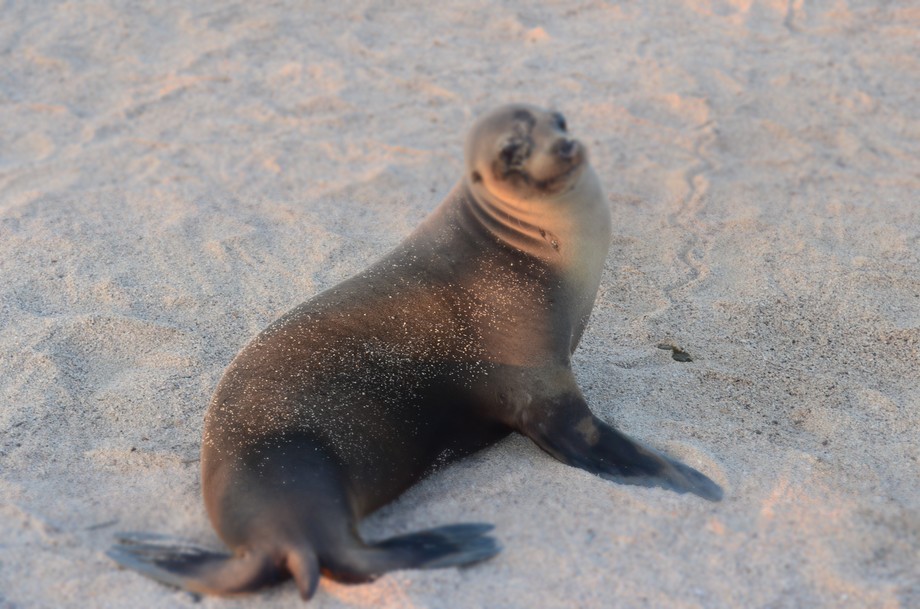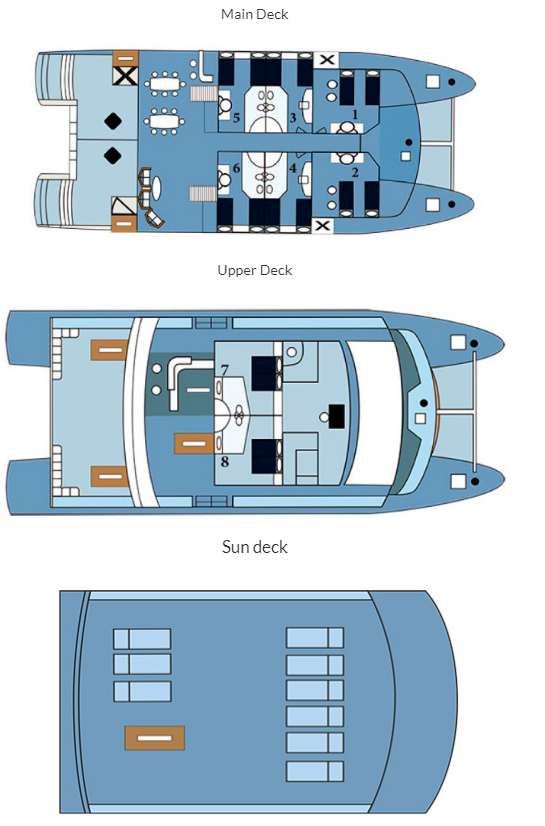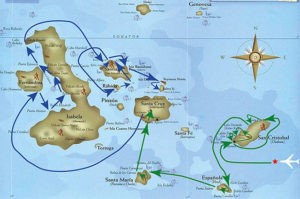
The best way to live a vivid trip in your Galapagos vacation is to cruise around the archipelago and experience the huge diversity between the varieties of islands. Our well-planned excursions at distinct sites allow you to encounter the natural wonders of these enchanted Islands and to understand its continuing evolution fully. You will learn about Galapagos land & marine wildlife, ora, geology, and history. Our excursions include visits to peculiar landmarks, wildlife trails, mangrove forests, tortoise breeding farms, research centers, marine sites, and more. Some of the activities you can enjoy are volcano-hiking, kayaking, snorkeling, amongst others.
Each meal on board is a treat for the taste buds as our chef prepares the finest international and local dishes using fresh ingredients of the highest quality. All meals include the choice of meat, poultry or seafood. In the case you have a food allergies or food restriction, we can adapt the menu to your requirements.The dining room and the big saloon are on the main deck, specially designed to offer a great ambiance to the passenger, both for a marvelous meal or a wonderful chat with the shipmates at the end of the day. The chef is delighted to mesmerize your taste with his dishes.
There are no future departures for this trip at this stage.
This day you will fly from Quito, Ecuador to the Galapagos. Afterwards, you will enjoy a quick 4 hour flight, with a quick stop at Guayaquil. Once in San Cristobal, a guide will meet you, collect your luggage, and escort you on the short bus ride to the harbor. Motorized rafts, called ‘Pangas’ will transport you to the M/C Seaman Journey and our crew will welcome you onboard. After departure and lunch, the first island visit is made. This is an interpretation center with exuberant gardens and stunning ocean views in contrast with the 1960´s buildings in Charles Darwin Center. Visitors at the interpretation center can learn a lot about the geological and human history of the islands, conservation facts and natural history. This is the oldest museum of Natural History in Galapagos Islands that is trying to preserve the nature of the islands.
-/L/D
A short visit to the Galapaguera that is a good place to observe Galapagos tortoises in its natural habitat.
San Cristobal island has endemic species such as: the Mockingbird Nesomimus melanotis, lava lizard (Microlophus bivittatus), Chatham Leaf-toed Gecko (Phyllodactylus leei) and the tortoises. All of these species can be observed in this place, the beach is really big and it works as a nesting zone for marine tortoises.
Between January and May, it is common to find the footprints of the female tortoises that have climbed to the sand dunes to deposit their eggs.
Cerro Brujo is a beautiful white coral beach where you can swim and watch birds and sea lions, plus you can snorkel.
This is the first coast where Charles Darwin ever walked on in 1835. In this marvelous lava landscape, you can see seabirds like blue-footed boobies, Nazca boobies, herons, frigate birds and shore birds. The protected bay is very popular to observe young tortoises and for swimming.
The pools with salty water behind the sand dunes were used by the fishermen as a salt mine in order to preserve food for the local population.
Among the fauna, you can observe the Chatham Mockingbird and the San Cristobal Lava Lizard, both species being endemic to the island and unique to the area as they cannot be observed nowhere else.
Furthermore you can find the island canary, the Galapagos turtles and with luck the little bird known as the Pájaro Brujo in Spanish, an endemic specie from San Cristobal Island. The vegetation covers all the route where you can find species like the candelabrum cactus and carob trees.
Located on the north coast of Isla San Cristobal, here Cerro Brujo, is the place where we can find a relaxing and beautiful place to be at.
B/L/D
Located on the north-eastern coast of Hood, we find Gardner Bay. It provides an excellent beach for relaxing, swimming, snorkeling, kayaking, and the opportunity to observe sea lions. Here we can also observe sharks in the crystal clear ocean waters.
Suarez Point is great for spotting blue-footed boobies, albatrosses and Nazca boobies. A beautiful site on the oceanfront, the large waved albatrosses use the cliff as a launching pad. The famous attraction is the magnificent blowhole, spurting water high into the air at least from 50 to 75 meters high. This site presents wonderful photograph opportunities.
B/L/D
This site offers probably the best flamingo lagoon in the Galapagos; it is also one of the largest in the islands. It’s situated between two tuff lava cones that give the area a special atmosphere. There are various species of shorebirds to observe besides flamingos; the most frequent are common stilts, white-checked pintail ducks, and other migratory birds.
It is very interesting to see the two distinct beaches: “The Green Beach” (due to its high percentage of olivine crystals in the sand) and the “Flour Sand Beach” which is made up of coral.
Historically, Post Office Bay is the location of a wooden barrel that was placed in the 18th century by the crew of a whaling ship. It has been used since this time by mariners and tourists as a post office. The idea is to carry letters or postcards to their destination by hand. Apart from being the Post Office Barrel, this site was the landing area for some of the first colonists.
We will continue to the north of the island and will ascent to an elevated slope to enjoy a beautiful vista at the Baroness lookout. It is said that Baroness Eloisa Von Wagner loved this place and spent several hours watching the horizon. Within walking distance (30 m) are the ruins of what is known as her house. From this lookout, the landscape covers the coastline from the Enderby islet to Post Office Bay, as well as Cerro Pajas, the pool of flamingos and wide forest of Palo Santo.
B/L/D
Although the great majority of Galapagos visitors come here to observe and appreciate natural wonders, it is also interesting to learn how the protection and conservation of the islands is carried out. One of the main attractions is the National Park information center, the Van Straelen Exhibition Hall, the Breeding and Rearing Center for young tortoises, Lonesome George (turtle from Pinta), and adult Galapagos tortoises in captivity.
Journeying across Santa Cruz into the highlands visitors are delighted by the island’s variety of life and geology. Beginning at the coast and traveling across Santa Cruz the road departs from Puerto Ayora climbing through the agricultural lands and into the mist covered forests. Santa Cruz possesses all of the various life zones present in the archipelago. Birds will surround you across this path. Whether it’s the bright red feathers of a vermillion flycatcher or one of Darwin’s Finch almost every bird present in the islands can be found here.
Santa Cruz offers excellent opportunities to observe the wild Galapagos Tortoises. Tracking tortoises is not the only exciting activity to be found in the highlands. There are also plenty of lava tubes, sinkholes and craters ready to be explored.
B/L/D
Off the eastern coast of Fernandina, Mangle Point can be found, a superior snorkeling site and a beautiful location for riding in a panga or zodiac through a grove of mangrove trees. A hike of about 1/2 miles is possible. While you are on your ride, you are likely to see sea lions, tortoises, pelicans, rays and birds too numerous to name them all.
Punta Moreno is located on the north coast of Isabela Island between the volcano Sierra Negra and Cerro Azul volcano. The trail runs along a lava flow Pahohoe (solidified lava in the form of corrugated or an accordion) into a complex of coastal lagoons, where several species of birds which can be found around this lakes and mangroves
B/L/D
Urbina Bay is located at the base of Alcedo Volcano on the west coast, between Tagus Cove and Elizabeth Bay. This area experienced a major uplift in 1954, which caused the land to rise over 16 feet. The coast expanded half a mile out, leaving marine life stranded on the new shore. This area is also a great place to snorkel. Urbina Bay is a path that starts off with a wet landing. The course is approximately 3200m, and made up of sand, pumice, lava, coral and vegetation where one can observe iguana burrows. It is an ideal place to see red and blue lobster!
In Bahia Urbina you can see Darwin’s finches. Its main attraction is the land iguanas, which are larger than in places like South Plaza Island and Galapagos tortoises also in the wild, sometimes even out of season they are on the bottom of the islands.
A large amount of vegetation can be observed such as chamomile and Rosewood, but among all these plants, the beautiful flowers of cotton Darwin, endemic to the Galapagos Islands stand out.
Tagus Cove is located west of Darwin Volcano on Isabela Island. This was a favorite spot for pirates and whalers, and it was them who started the following tradition: the inscription of the names of boats. At the beginning of the trail, you will see a small cave where you will find inscriptions dating to the 1800s.
Its name originated from a British warship that went across the islands in 1814 looking for Galapagos Tortoise for food.
Due to former eruptions, the substrate has a large amount of volcanic rocks of different sizes, among the most common are little balls of nearly spherical shape known as the “lapilli” or petrified rain.
B/L/D
Espinoza Point is a famous place known for its large colonies of marine iguanas and as the habitat of unique species like the flightless cormorant, Galapagos penguin, Galapagos hawk, and Galapagos snake.
One of the most impressive and spectacular places of the enchanted Galapagos Islands; with high cliffs and tuffstone, ash and lava formations give this area a majestic touch, is Punta Vicente Roca. It is located in the north-western coast of the island; comprises two distinct islets. This large bay has a spectacular marine life.
Here, you can see seahorses, sea turtles and the strange yet fascinating Mola-mola or sunfish. This bay is a great place to practice Panga Ride and Snorkeling.
We can as well find: Penguins, Blue-footed boobies, Terns, Boobies, Sea lions. Also you can snorkel and observe sea turtles, stingrays and puffer fish.
B/L/D
Espumilla beach is located on the northern coast of Santiago Island in James Bay. During the last presence of the El Niño phenomenon, one of the two lagoons in this site, underwent a process of sedimentation, thus causing the disappearance of a representative colony of flamingos. The main attractions are the palosanto forest and the nesting of baby turtles.
The black beach of Puerto Egas is located on the west side of the island and is the main attraction of the island. Their volcanic tuff deposits have favored the formation of this special black sand beach.
This site is called Puerto Egas, because there was an attempt to start the exploitation of salt, which failed because the price of salt in the continent was very cheap, and did not justify its exploitation in Galapagos. The project was abandoned and the infrastructure was left abandoned.
B/L/D
Rabida Island is unique due to the red color that colours all rocks and sand. The volcanic material in this island is very porous and external factors as rain, salty water, and sea breeze have acted as an oxidizing agent.
A short walk along a trail leads you to a coastal lagoon behind the beach which permits you to observe the land birds such as finches, doves, yellow warblers, and mockingbirds. At the lagoon there is a colony of flamingos.
The Chinese is a small islet (1 sq km) located just off the southeastern tip of Santiago Island. It is a recent volcanic cone, shaped like a Chinese hat when seen from the north. On the west you can see lava formations, formed under the sea and raised upwards, this is why coral heads are found on the lava. This is an excellent visit for interpretation of geological features such as lava tubes and lava flows. The landscape is covered by sea lions colonies, marine iguanas, and Galapagos penguins.
B/L/D
Santiago, also called James, or San Salvador Island, is located in the west central part of the Galapagos archipelago. It is the fourth largest island in the archipelago (following Isabela, Fernandina and Santa Cruz). Along with some of the large western volcanoes of Isabela and Fernandina, Santiago is also volcanically active, with many young flows and cones to be seen, particularly along the south, west, and east coasts. These may even be seen from the summit of Darwin Volcano and from space. A number of historic eruptions have been
reported over the last 2 centuries. Santiago actually consists of two coalesced volcanoes: a typical shield volcano on the northwest end and a low, linear fissure volcano on the southeast end.
Bartolome Island is situated across Sullivan Bay. It has an altitude of 114 meters , from where we can observe one of the most beautiful sceneries of the Galapagos Islands such as: Volcanic cones, lunar – like craters, lava fields, and the famous Toba formed pinnacle eroded by the sea. There is very little vegetation on this island. It has two breathtaking beaches where marine turtles exist and at the base of the pinnacle, as well as a very small colony of Galapagos penguins.
B/L/D
The two small beaches of Bachas Beach are found to the West of Turtle Cove. Their sand is made of decomposed coral, which makes it white and soft, making it a favorite nesting site for sea turtles. Behind one of the beaches there is a small brackish water lagoon, where it is occasionally possible to observe flamingos and other coastal birds, such as black-necked stilts and whimbrels. The other beach is longer, but it has two old barges that were abandoned during the Second World War, when the USA used Baltra Island as a strategically point to protect the Panama Channel.
After the morning excursion you will be taken to the airport for your flight to the mainland.
B/-/-
Galapagos Seaman Journey

The Galapagos Seaman Journey is a first class catamaran that began sailing the Galapagos Islands in January 2008. It is a Boutique Yacht Catamaran offering superior comfort, size, style, and stability. The Galapagos Seaman Journey makes it possible to enjoy several cruises in the Galapagos with different itineraries that include amazing land tours on most of the Galapagos Islands. During these Galapagos Cruises, guests encounter many endemic species like Galapagos Giant Tortoises, Penguins, Land and Marine Iguana´s, Frigate Birds, Blue Footed Boobies, and much more! During one of the cruises you can enjoy the well-furnished areas offering comfort and privacy. Galapagos Seaman Journey has a maximum capacity of 16 passengers allowing both intimacy and camaraderie at the same time.
There are several resting areas for those who are looking for a quiet place to relax during their Galapagos trip with family and friends in the lazy mid-afternoon sun, or likewise after a busy day of swimming, snorkeling, kayaking, or walking on one of the Galapagos Islands. To check out the gorgeous ocean views with fellow shipmates, you can spend some time on the liveaboards’ spacious sundecks. Whether you feel like getting a little sun on your vacation, or want the best place to enjoy the gorgeous sunsets over the Galapagos Islands, the sundecks are the best place to be. For the adults who might want to relax and kick back, we offer a great bar and lounge area where you are served by our bartender who will be happy to attend to all your needs and desires whilst you relax.



